#Spelling Guide
Explore tagged Tumblr posts
Text
(Overly) Concise Style Guide Version 1
the spelling is to be regiolect agnostic
Diacritics used to indicate sound changes in letters should be avoided .i. {ä}{è}{ï}
General Spelling Rules
A word that is not in the genitive or plural should not end in a single sibilant.
‘Z’ is used for the voiced sibilant in all instances except the plural
A word should not end in an ‘I’
Two ‘I’ cannot follow each other
Digraph [au] when initial and medial and [aw] when terminal
Digraph [ou] when initial and medial and [ow] when terminal
Digraph [oi] when initial and medial and [oy] when terminal
Digraph [ei] when initial and Medial and [ey] when terminal
Digraph [ai] when initial and medial and [ay] when terminal
Digraph [ey] when initial and medial yet trigraph [eye] when terminal
Digraph [ui] when initial and medial and [uy] when terminal
Preference for digraph [ee] over [ei] in monosyllabic words
Preference for [ck] over [kk]
do not use "glided" spellings as is ane -> yin un- -> wan- etc.
Harmonisation with English
Concerning the use of digraphs verses silent-E, where a digraph is used in English so too should it be in Scots and silent-E likewise.
So,
English Dream, Soon, Please, Week, Weak, Great Scots Dreem, Suin, Pleeze*, Week, Week**, Greet NOT Dreme, Slepe, Plize, Weke, Weke, Grete
*see General Spelling Rule 2. & see **3.
And,
English Home, Bone, Phone, Prune Scots Hame, Bane, Fone, Prune NOT Haim, Bain, Foan
Declension
Declension does not alter terminal ends of words (hence day -> days dais). Nouns are declined for Number (Single & Plural) and Case (Nominative & Genitive).

Conjugation
conjugation does alter terminal ends of words (hence say -> said, sain)
1 note
·
View note
Text
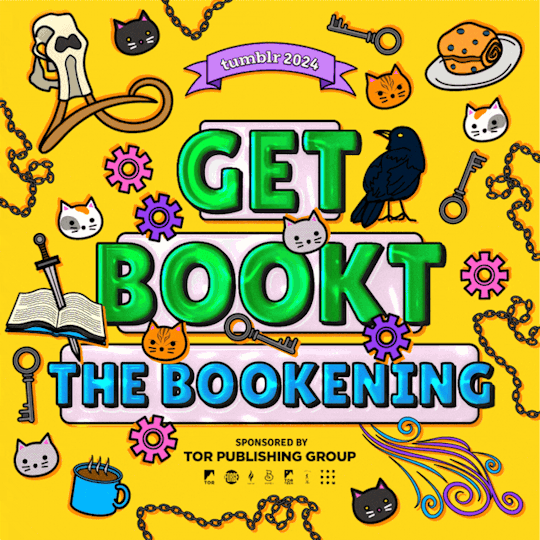
Tor Publishing Group is BACK (again) with a guide of books to gift the people in your life…and yourself!
━ ˖°˖ ☾☆☽ ˖°˖ ━
Cozy books to curl up with in the winter...

Legends & Lattes / Bookshops & Bonedust by Travis Baldree
The Spellshop by Sarah Beth Durst
Can’t Spell Treason Without Tea by Rebecca Thorne
━ ˖°˖ ☾☆☽ ˖°˖ ━
Dazzling new worlds to explore...

The Dead Cat Tail Assassins by P. Djèlí Clark
Blood of the Old Kings by Sung-il Kim; translated by Anton Hur
━ ˖°˖ ☾☆☽ ˖°˖ ━
High stakes, high thrills...
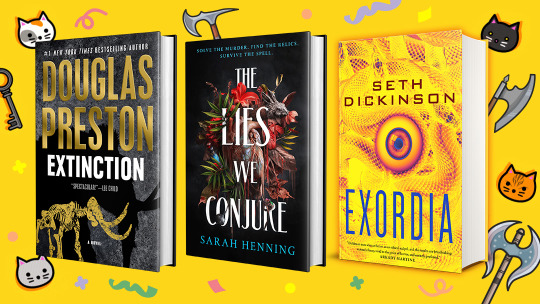
Extinction by Douglas Preston
The Lies We Conjure by Sarah Henning
Exordia by Seth Dickinson
━ ˖°˖ ☾☆☽ ˖°˖ ━
Story collections that pack a punch...

Januaries by Olivie Blake
The White Guy Dies First: 13 Scary Stories of Fear and Power edited by Terry J. Benton-Walker
Not enough books? Don’t worry, we have another GET BOOKT: THE BOOKENING guide to help you out!
#Tor Books#Booklr#gift guide#getbookt#thebookening#getbooktthebookening#Bramble#TDCP#Tordotcom Publishing#Forge#The Spellshop#Sarah Beth Durst#Can’t Spell Treason Without Tea#Rebecca Thorne#Legends & Lattes#Bookshops & Bonedust#Travis Baldree#Blood of the Old Kings#Sung-il Kim#Anton Hur#The Dead Cat Tail Assassins#P. Djèlí Clark#Exordia#Seth Dickinson#The Lies We Conjure#Sarah Henning#Januaries#Olivie Blake#The White Guy Dies FIrst#Terry J. Benton-Walker
1K notes
·
View notes
Text






And he is done! Well except for the wig... But yeah a very very fun project. Only made possible by the lovely @k0mmari and their incredible Endless Abyss Travel Guide!
I mainly pulled the base from this version of the Watcher design, but stuff like the pattern of the fabric of the skirt and the inside of the sleves were inspired by this eg the og form and the idea of the incorporeality of the Watchers. Going along with that I added 2.5 cm horsehair braid to the edge of the skirt to get it to be a bit flowy to keep that illusion going.
Hand in hand with that goes that I decided that I wanted to wear a bodysuit underneath the robes to emulate "skin so pale it looks almost grey" (paragraph 35) and me not having to worry about binding or body paint.
The robes are a modified hanfu pattern, the only difference is that I had to rotate the placement of the sleeves in the armhole bc they woudnt fall correctly if I didnt do that. Same with the skirt, it started as pants but they didnt look correctly so I made them into a skirt.
I really really like the beading I did for the center pieces of both the belt and the collar. The different fabric textures and different types of beads give it some really nice dimension.
As for the belt piece itself... According to the research I did into fu talisman it seemed like it wasnt okay to just emulate the look for funsies 1:1 so I couldve either done gibberish or actual chinese characters for mine. After a good friend of mine weighed into that I ended up using actual characters, some that relate to the design/story and some funny ones as well. (Spot the cucumber salad)
Anyway I was also very happy to have found this off-white cotton that I used on the tabard (?)/scapular (??), the collar and the sleeves. I think the print works wonderfully with the overall design and ties everything together.
Ill will probably wear the costume at a con next month but I have no idea how to plan a photoshoot for him in regards to the location. Recommendations are very welcome :)
#svsss#cosplay#sewing#komm's endless abyss travel guide#endless abyss travel guide#man my grammer check isnt working so sorry for the spelling mistakes#i loved working on this one#truly#herzblut as we say in germany#cant wait to start working in the wig#it should arrive within this week
283 notes
·
View notes
Text
How easily can you top him?
The fandoms for this: Bungo stray dogs, Saint spells love guide, Honkai star rail
Notes: I’m a minor writing smut, if you aren’t comfy with that then just scroll, I don’t care what you have to say just scroll or block because I’ll keep writing even if you don’t want me to.
I didn’t put every single Saint spells character cuz I didn’t do every route (and for HSR I just don’t care for some of the guys and I hate that gay looking bitch Luocha he’s always showing up in my month for slideshows LIKE GET OUT OF HERE YOU FUCKING ZEST FEST YOU MAKE ME HOMOPHOBIC YOU ANNOYING ASS PIECE OF SHIT)
Edit: thx ppl in the comments for reminding me who Ango is, it’s been edited :3
This took me forever BUT NOW I CAN FINALLY DIE

Go ahead, he likes being topped (or he’s usually the bottom anyways)
Okay these guys looove when you’re on top, they get so excited at the site of you on top of them that they can barely hold back their noise when you’re moving, they’ll even start whimpering if it starts feeling too good. They’re so fun to too because you know they’ll let you fuck them stupid if you want <33
Ango Sakaguchi, Atsushi Nakajima, Ranpo Edogawa, Dazai, Gepard Landau, Caelus, ERiS
Yes, but please be gentle and treat him with love <3
They’d be perfectly fine with you on top but please don’t be rough and mean :( they need lots of love if they’re going to let you be in control, please make sure they know you still love them! Praise them please!!
Ashton Harlow, Titus Brome, Atsushi (again), Akutagawa, Argenti, Aventurine, Sunday, Luca Michaelides, Hui Shi, Barnaby Lei, Spinel Spiralis
Yes, and they’ll be praising you the whole time
The praises slip out of their mouths so naturally, seeing you on top of them does things to their body and mind. Talkative or not- prepare yourself for their endless praises while you fuck them/ride them
Chuuya <3, Kunikida, Tecchou, Sigma, Luca Michaelides, Spinel Spiralis, Hui Shi, Sunday, Argenti, Dan Heng, Welt Yang (idk what ppl see in him but he gets a spot)
Nah you aren’t topping, say bye bye to your ability to walk straight
Really? You think it’s possible to top them? They could’ve been gentle but now they probably won’t be! They’re pretty much impossible to top or have any kind of control over, so they’ll make sure you get that in your head
Jing Yuan (pls hear me out), Veritas Ratio, Blade, Bugbear, Siri, maybe Salinger? (I’ll probs play his route again to make up my mind), Fyodor, Nikolai, Jouno
#saint spells love guide#bsd x reader#HSR x reader#honkai star rail x reader#bsd smut#HSR smut#Chuuya smut#Kunikida smut#Atsushi Nakajima smut#Akutagawa smut#Dazai smut#I’ll add more tags later when I’m not lazy 💀#Blade smut#Aventurine smut#Jing Yuan smut#Dan Heng smut#Veritas Ratio smut#Dr Ratio smut#HSR Sunday smut#Argenti smut#Welt Yang smut#Gepard Landau smut#Ranpo smut#Rampo smut#Sigma smut#Nikolai Gogol smut#Fyodor smut#Saigiku Jouno smut#Ango Sakaguchi smut#Tecchou smut
893 notes
·
View notes
Text
So I did a thing and converted all my digital grimoire files to PDFs and put them on gumroad for five dollars. This is basically my entire basic catalog of information on magick and witchcraft and makes a fantastic resource for anyone looking to learn occult practices. Any money made will go back towards my witchcraft and art. 🖤
Click here to download.
#witch#magick#lefthandpath#satanic witch#witchcraft#dark#satanism#witchblr#demonolatry#spirit work#spirit#grimoire#eclectic witch#eclectic#pagan#chaos witch#chaos magick#spellcasting#spell work#spells#spell#occult#esoteric#guide#knowledge#fae#divination#necromancy#herbalism#crystals
114 notes
·
View notes
Text


Mindscape, based on this post I made weeks ago
The yellow light is Flapjack's life force 😭😭😭😭
#toh hunter#the owl house#hunter noceda#hunter deamonne#smol hunter#toh edits#loz's edits#putting therapist-related notes here in the tags: Understanding Willow is my fave Season 1 episode --#coz exploring mindscapes..seeing your inner selves - esp the inner child - is a metaphor for something you can absolutely do in therapy#so this scene can easily be something that Hunter's therapist is guiding him through. in his imagination#it might not necessarily require the use of the same spell that Eda or the CaTTs used to enter Willow and Belos's mindscapes#and besides - for those episodes..other people were exploring their mindscapes. so this is different I guess#it could easily be a therapy exercise to connect to his inner child#and note: this is different from EMDR therapy as per my EMDR-related Hunter posts. this could be under a diff style of therapy --#such as Internal Family Systems (IFS therapy)#if it's EMDR...then it'd likely involve both Hunter's therapist & him exploring his memories. Hunter reports to the therapist what he sees#and the therapist would not be allowed to interpret the memories by himself/herself/themselves#his/her/their job in EMDR would be to reflect whatever Hunter shares back at him and guide him towards integrating traumatic memories
277 notes
·
View notes
Text

rocket raccoon au where he works a minimum wage fast food job and he’s at the end of his rope so he smokes 5 packs a day to cope
#he spells your name wrong on purpose if he doesnt like you btw#don’t ask me why i decided to make this because i don’t know either#stupidest shit i ever drew but what can i say? the hand of god doth guide me#anyway work has sucked.#my art#shyly art#rocket raccoon#guardians of the galaxy#gotg#gotg fanart#guardians of the galaxy fanart#rocket raccoon fanart#marvel fanart#mcu fanart
128 notes
·
View notes
Text
A kinda-chunky info comic(?) about asexuality and aromanticism, in celebration of International Asexuality Day today!!
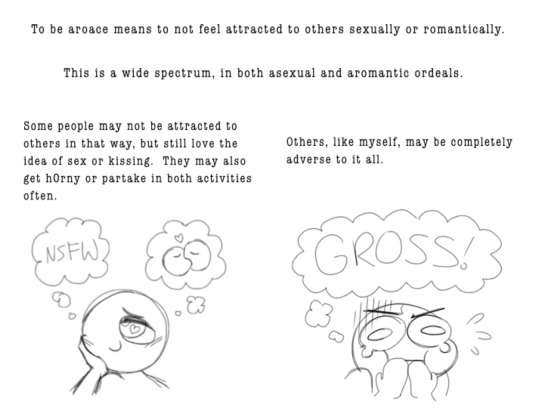

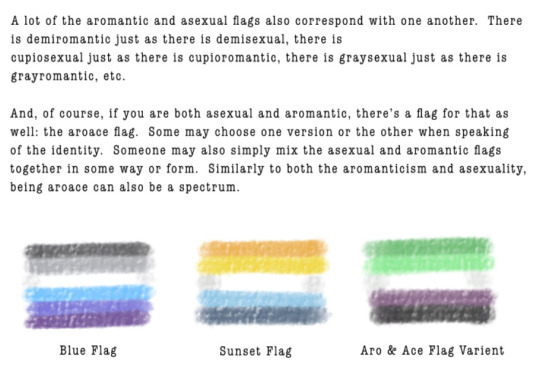




Also, I’m not trying to erase asexual representation today by explaining aromanticism as well, I just thought it would be useful to explain both in this comic, as they’re so closely related, and I’m not sure the next opportunity I’ll get to make a whole other comic for aromantics. Not to mention I’m both, and don’t want to explain asexuality in a skewed or inaccurate way because of that fact
#I’ll work on adding all the alt text throughout the day#I’m super busy today and can’t do it all atm as much as I want to#asexual#aromantic#aro ace#what is asexual#guide#pride#international asexuality day#lgbtqia#if you see spelling errors no you don’t#it’s hard to spell so late at night
502 notes
·
View notes
Note
If its not maya nor mia how do you pronounce it
Ma-ee-a? Mey-a? May'a???
YOU PRONOUNCE IT THE SAME AS MAYA BUT IM STILL NOT CALLED "MAYA" OR "MIA", THAT BIT IN MY BIO IS ABOUT THE SPELLING NOT THE PRONUNCIATION IT'S NOT THAT HARD TO UNDERSTAND
#i get this ask like once a week and i genuinely don't know if yall are actually this stupid#im just annoyed by people who call me 'maya' or 'mia' in asks or notes as if it doesn't say my name all over my profile already#but i might have to remove the spelling guide now because yall don't get that either apparently#im not actually mad but im a bit tired#all caps
310 notes
·
View notes
Text
100 Witchcraft Tips in 100 Days!
Day 3 - How to Turn Herbs into Loose Incense

Turning your herbs into a blend of loose incense is a wonderful way to connect with the energies in your plants. It not only can be used to make your home or living space smell nice, but can also be used for a variety of practices. Whether it's for smoke divination, cleansing, or spells there's a blend for every intention.
Gathering Ingredients
There are 3 types of ingredients used for loose incense; herbs, resins, and wood shavings. Herbs are the most versatile of the bunch. There are a plethora of different herbs each with their own correspondences. Some notable basic herbs that every witch should have laying around somewhere include basil, bay leaves, chives, cilantro, dill, oregano, mint, parsley, rosemary, and thyme. Resins are your tree saps, these include frankincense, myrrh, pine sap, and dragon's blood. Wood shavings are self explanatory, they're pieces of bark and wood from trees. Make sure before proceeding that you know the herbs, resins, and wood shavings are safe to burn. Some herbs, resins, and wood shavings can be toxic to humans and pets.
Preparation & Blending
To prepare your herbs to be blended into your loose incense you want to make sure they're 100% dried to ensure they don't grow mold and they burn well. You can dry your fresh herbs by hanging them upside down in a well ventilated room. Once the herbs are dried, use a mortar and pestle to grind dried herbs and resins into either a fine powder or coarse blend, depending on your preference. As you grind these herbs focus on what they do and how they contribute to your intention and blend them together. You may need to adjust the ratios depending on the strength of each ingredient, but you'll figure that out as you learn more.
Binding & Burning
Binding is an optional step when making loose incense, however, adding a small amount of powdered charcoal or gum arabic can help make your blend burn more evenly. When you're not actively burning your loose incense make sure to store it in an airtight container so it doesn't loose it's potency. There are multiple methods to burn loose incense, however, I like to create sigil shaped incense trails. There are multiple ways to make incense trails. One of such ways is to spoon the powder into a mold placed on a bed of ash, this method originates from China. The method I use includes pouring it out in the general shape of the sigil, then I pat it down with my fingers and fix any errors I may have made when compacting it. Once you've made your trail you simply light one end and let it burn.

Simple Blends by Intention
Protection Blend - Used for cleansing your space and creating a protective barrier against negativity
Rosemary (Protection, Purification) - Potent protector, often used to clear negative energy and set boundaries.
Bay Leaves (Protection, Strength) - Used in this blend to amplify the shielding energy.
Cedar (Grounding, Protection) - Provides grounding and strengthens the protection created by the rosemary and bay leaves.
Frankincense Resin (Spiritual Protection, Purification) - Used for protection and connection with your higher self.
Abundance and Prosperity Blend - Used to attract wealth and prosperity
Basil (Wealth, Abundance) - Used to draw wealth and secure success.
Cinnamon (Success, Prosperity) - Typically considered fast acting and bringing rapid results.
Mint (Financial Gain, Luck) - Commonly used to bring luck in financial matters.
Clove (Attraction, Manifestation) - Used to strengthen manifestation, helping to focus your intent on drawing in wealth and success.
Peace and Relaxation Blend - Used for meditation, relaxation, or healing after emotional stress
Chamomile (Calm, Relaxation, Healing) - Used to bring gentle healing, diffusing tension, and creating a peaceful atmosphere.
Lavender (Peace, Calming Energy) - Promotes peace, calm, and sleep.
Lemon Balm (Emotional Healing, Calm) - Aids in emotional healing and brings a gentle clarity to situations.
Mugwort (Dreamwork, Relaxation) - Used for enhancing intuition and calming the mind.
Spiritual Growth and Intuition Incense - Used for rituals focusing on spiritual growth, meditation, or divination
Sage (Cleansing, Spiritual Clarity) - Powerful cleansing herb that helps clear the mind and create a space for spiritual work. Please use common sage and not white sage.
Mugwort (Intuition, Psychic Development) - Enhances psychic abilities and helps to deepen your intuition.
Frankincense Resin (Spiritual Connection, Purification) - Aids in connecting with your higher self.
Cedar (Grounding, Spiritual Protection) - Provides grounding energy, ensuring that you will stay rooted and protected during rituals.
If you want to find more of these entries use the hashtag #100 Witchcraft Tips in 100 Days! If you want to join a group of witches feel free to join our 18+ coven on Discord.
#magick#paganism#witchblr#witchcraft#baby witch#pagan#witch stuff#witch#witch community#beginner witch#beginner witchcraft#beginner guide#100 days challenge#100 Witchcraft Tips in 100 Days#incense#correspondences#spell#ritual#magic#eclectic pagan#herbal witch#herbal magic#herbs#green witch
201 notes
·
View notes
Note
any recommendations for light/silly fantasy for someone who's read most of them? favourites are: finding home by hari conner, so this is ever after, emily wilde, the ruthless lady's guide to wizardry, legends and lattes, terry pratchett. also liked the very secrety society of irregular witches, the league of gentlewomen witches, tress of the emerald sea, some other f t lukens books, swordheart, fangs by sarah anderson. so anything with those vibes that are not one of those. I do want to read half a soul and psalm for the wild-built but I can't get them currently through my library.
Wow you were not kidding when you said you had read most of them! Many we would typically recommend are already in your list, but we DO have some more for you that hopefully you haven't read!
Oh, and real quick: You may have already done this, but if you haven't - check and see if your library has a purchase request or interlibrary loan service. Many libraries do, and often people don't know about it. They might be able to get you Half a Soul and Psalm for the Wild-Built if they know you're looking for them!
Now on to the recs:
Rachel says:
I have not read it yet, but I have heard great things about A Lady's Guide to Marvels and Misadventure by Angela Bell. And as a kid, I loved Bunnicula by James & Deborah Howe.
Abby says:
Try A Spell for Heartsickness by Alistair Reeves. The MC is a manic witch with a snarky corvid familiar, and they have to navigate setting up shop in a remote village that's harboring secrets and surrounded by some creepy woods.
Since you like FT Lukens I think you'd like this too.
Robin says:
In Other Lands by Sarah Rees Brennan - it's portal fantasy and the main character is incredibly genre aware. And sarcastic about it. The author is on tumblr and it shows (in a good way!)
Since you like T. Kingfisher, if you haven't continued on with Paladin's Grace yet it's very much in the vein of Swordheart so give that a look. You could also try A Wizard's Guide to Defensive Baking which is a bit different to the World of the White Rat books but still great!
The Enchanted Forest Chronicles by Patricia C. Wrede was a formative read for me. Princess Cimorene is determined to avoid marriage so she arranges to get herself carried off by a dragon. It's a delight. Start with Dealing with Dragons.
--
Hopefully there are a few there you haven't read yet and that you'll like! You can also check out our fantasy tag for all the fantasy recs we've made here over the years, light-hearted and otherwise!
#book recs#book recommendations#t kingfisher#sarah rees brennan#in other lands#alistair reeves#fantasy#LCPL reply#LCPL recs#robin's recs#abbyrecs#rachelrecs#a lady's guide to marvels and misadventure#angela bell#a spell for heartsickness#paladin's grace#a wizard's guide to defensive baking#the enchanted forest chronicles#patricia c wrede
86 notes
·
View notes
Text



elaboration on (my headcannons of) Betelgeusian features
#h2g2#zaphod beeblebrox#ford prefect#h2g2 fanart#douglas adams#the hitchhiker's guide to the galaxy#hitchhiker's guide to the galaxy#scifi#character design#alien anatomy#hhgttg#bullshitting champion march 2025#bullshitting or having fun#i feel like zaphod’s energy regulation would be a bit more sensitive#due to the DIY brain surgery…#i also think betelgeusians mate for life#forthur 4 life#literally#excuse any spelling errors if there are
67 notes
·
View notes
Text
me rn because Powerless has so many consistency errors and nonsensical conversations I genuinely feel like I am losing my ability to read

#they keep saying one thing and then the exact opposite within the same conversation#the main character's name is spelled two different ways within the same paragraph#online guides and summaries claim the event that the plotline surrounds is different from what is described in the book#fighting for my life as we speak. this is what i get for paying attention to what i read#eernatalk#kai: you are a prize i am trying to win#paedyn: WHAT THE FUCK??? I AM A TROPHY???#kai: no??? what'???' what are you saying right now??????? you are not something i can win?????????? you have to choose me <3 i am a good gu
71 notes
·
View notes
Text
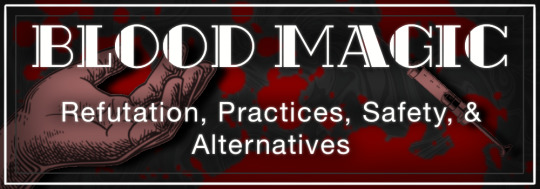
[TITLE]: Blood Magic: Refutation, Practices, Safety, & Alternatives
Recommended Reading
Basics of Binding Anchors Basics of Spellcasting Spell Circles Correspondences Altars: Uses & Designs Spell Logs Energy Work: Fundamentals Bias in Witchcraft
IMPORTANT:
This article discusses blood magic as well as the actions and elements associated with it such as: bloodletting, infection, self-harm, and open wounds. Readers are encouraged to approach the content with critical thinking and sensitivity. If you find such topics uncomfortable or distressing, I advise against continuing further. The information presented is for educational purposes only and should not be construed as medical advice. Should you choose to engage with blood magic, it should be done so with respect for cultural traditions and safety considerations, which will be outlined. This article is not to encourage the use of any harmful practices, only to educate.
If you find the subject to be triggering but still wish to engage with the information, the last section of this article (highlighted in blue) has a diluted list of the article without triggering content and goes over alternatives for blood magic.
Like always, an asterisk* is used as a marker for a closed or semi-closed practice.
Introduction
Blood magic involves the ritualistic use of blood as a potent symbol and conduit for connection. Central to blood magic is the belief that blood, as the essence of life and vitality, carries inherent energies that can be harnessed and directed. This doesn’t necessarily require blood to be removed from the body. In a few cultures, such as Traditional Chinese Medicine, Ayurvedic Medicine, and some indigenous practices blood is utilized from within the body as a means for healing, directing energy from the subtle body, and developing a more thorough mind-body connection.
The applications of blood magic span a spectrum of purposes, each rooted in the practitioner's intentions and the energetic resonance of blood itself. While practices vary widely across cultures and individual traditions, common themes emerge regarding the uses of blood magic. Applications such as warding, binding, divination, and energetic balancing.
Please be sure to engage in this entire article if you are able, and do so in good faith. Blood magic, as a legitimate magical practice, has been influenced and poorly reflected by media which has resulted in a portent of misinformation and misunderstandings. The aim of this article is to eliminate misunderstandings and promote safe and ethical practices.
Uses
Blood magic is employed for several purposes, each rooted in the idea that blood is a conduit of life force and energy. Primarily, blood magic is utilized in rituals aimed at strengthening bonds. It is believed that by incorporating blood into rituals, one can forge stronger connections with ancestors, deities, or the natural world. This practice is seen in various indigenous traditions where blood offerings are made to honor and appease spirits or gods.
Moreover, blood magic is often used in rites of passage. These ceremonies, marking significant transitions in an individual's life, such as birth, maturity, marriage, and death, incorporate blood to symbolize the transformation and the continuity of life. The act of shedding blood during these rituals is seen as a potent gesture, signifying the shedding of the old self and the emergence of a new, empowered identity.
In healing practices, blood magic is employed as a method of channeling energy to promote physical, emotional, and spiritual well-being. Traditional healers may use blood as a medium to draw out negative influences or to invigorate the body’s natural healing processes. This practice is not about the physical use of blood per se but rather the symbolic gesture, wherein the essence of life is called upon to restore balance and harmony.
The portrayal of blood magic in popular media has often led to widespread misconceptions and fear. Frequently depicted as sinister and malevolent, blood magic is associated with dark rituals, malevolent sorcery, and nefarious intentions. Such representations overlook the cultural and spiritual significance embedded in these practices, reducing them to mere sensationalist tropes.
A prevalent misunderstanding is the belief that blood magic is inherently evil or dangerous. This notion is fueled by horror movies, novels, and sensationalist media, which often portray blood magic as the domain of malevolent witches or nefarious cults. In reality, blood magic, like many other forms of spiritual practice, is neutral in nature. Its moral alignment is determined by the intent and ethics of the practitioner. For many cultures, blood magic is a sacred practice meant to honor life, foster healing, and maintain harmony with the natural and spiritual worlds.
Another common misconception is that blood magic involves human sacrifice or self-harm. While historical accounts do exist of bloodletting practices, particularly in ancient civilizations, modern practitioners of blood magic typically engage in symbolic acts rather than literal bloodshed. These acts can include pricking a finger or using animal blood obtained from ethical sources, rather than causing significant harm.
Furthermore, the false association of blood with the empowerment of spells is a particularly egregious misrepresentation. Blood is often depicted as a supernatural catalyst that amplifies magical abilities, granting practitioners extraordinary power. This portrayal is not only inaccurate but also undermines the cultural and spiritual significance of blood magic. The following is a list of media that inaccurately portrays blood magic or has been poorly represented in subsequent media.
"The Book of Sacred Magic of Abramelin the Mage" (15th century)
"The Lesser Key of Solomon" (17th century)
"The Greater Key of Solomon" (17th century)
"The Key of Solomon" (14th or 15th century)
"The Grimoire of Armadel" (17th century)
"Rosemary's Baby" (1968)
"The Craft" (1996)
"Harry Potter and the Philosopher's Stone" (2001)
"Harry Potter and the Half-Blood Prince" (2009)
"Buffy the Vampire Slayer" (1997-2003)
"True Blood" (2008-2014)
"American Horror Story: Coven" (2013)
"The Magicians" (2015-2020)
“Supernatural” (2005-2020)
"Dracula" by Bram Stoker (1897)
"The Vampire Chronicles" by Anne Rice (1976 onwards)
"Harry Potter" series by J.K. Rowling (1997-2007)
"Twilight" series by Stephenie Meyer (2005-2008)
While some of these pieces of media do not directly promote the idea of literal bloodletting or the direct concept of magical strengthening through blood, their depiction and influence in later media does.

Process
The amount of blood required in blood magic rituals varies significantly depending on the specific tradition and the purpose of the ritual. Generally, only a minimal amount is used, symbolizing the essence of life rather than its physical manifestation. This minimalism underscores the principle that the power of blood magic lies not in the quantity of blood, but in the act of offering and the symbolic gesture it represents.
In most practices, a few drops of blood are deemed sufficient. This small quantity is often enough to establish the connection or achieve the desired outcome without causing harm to the practitioner. Overuse of blood is generally avoided, as it is not the volume but the act of offering that holds significance. This approach reflects a deep respect for the body and its life-giving essence, ensuring that the practice remains sustainable and safe.
Obtaining blood for these rituals must be approached with care and reverence. The method of extraction should prioritize the well-being of the practitioner or the source, emphasizing minimal harm and ethical considerations.
Self-pricking with a sterilized needle or lancet is a common method. This technique ensures that only a small amount of blood is drawn, usually from the fingertip. The use of sterilized instruments is crucial to prevent infection and maintain hygiene. The act of self-pricking is often performed as part of a ritualistic process, with practitioners mentally preparing themselves and ensuring a clean environment.
In rare instances, some practitioners may opt for menstrual blood, which is seen as a natural and potent symbol of life and fertility. The use of menstrual blood is often considered deeply personal and is typically reserved for specific rituals related to fertility, protection, or transformation.
In some traditions no bloodletting is required. Some of the most prominent traditions that use internal blood magic are Traditional Chinese Medicine and Ayurvedic Medicine. These traditions employ methods that emphasize the internal circulation and quality of blood as integral to health, vitality, and spiritual balance.
Traditional Chinese Medicine (TCM)*:
Within Traditional Chinese Medicine, blood holds a vital role alongside Qi (life energy) as one of the body's fundamental substances. Blood, known as "Xue," is considered essential for nourishing the organs and tissues, promoting growth, and maintaining overall vitality. Unlike external applications or rituals involving blood, TCM focuses on cultivating and balancing the body's internal blood through herbal medicine, acupuncture, and dietary therapy. Practitioners diagnose imbalances in blood quality and circulation based on symptoms such as pale complexion, menstrual irregularities, or insomnia, and tailor treatments to restore harmony within the body's systems.
Ayurvedic Medicine*:
In Ayurveda, the traditional medicine system of India, blood (Rakta) is regarded as crucial for maintaining overall health and vitality. Ayurvedic texts emphasize the importance of balanced blood circulation and purity to prevent disease and promote longevity. Practices such as Panchakarma treatments aim to cleanse and rejuvenate the blood through herbal therapies, dietary adjustments, and lifestyle modifications. Unlike external applications or ritualistic uses, Ayurvedic medicine focuses on enhancing the body's internal mechanisms to optimize blood quality and circulation. By restoring balance to the doshas (body types), Ayurvedic practitioners aim to harmonize physical health, mental clarity, and spiritual well-being.
Across these traditions, the approach to blood magic diverges from external ritualistic practices commonly associated with Western occultism. Instead, they emphasize internal cultivation, balance, and harmony within the body's natural processes. By focusing on enhancing the quality and circulation of blood through holistic methods, practitioners seek to promote holistic health, longevity, and spiritual well-being without the need for external bloodletting or ritualistic practices seen in other magical traditions.
Physical Applications of Blood in Use of Magic
The physical applications of blood in these practices are varied, each carrying distinct symbolic meanings and ritualistic purposes. Blood is often used to anoint objects, spaces, or individuals, thereby consecrating and imbuing them with specific properties. So long as blood is applied to archival materials and kept in a cool, dry, sterile, and dark place with little to no air circulation the DNA which makes up the taglock can remain intact for up to 500 years. However, luminal, microbial, fungal, and or chemical interactions may cause DNA to degrade in as little as a few days.
Anointing Objects: Blood is frequently applied to ritual tools, such as athames, wands, or talismans, to consecrate them and enhance their efficacy. This act is believed to imbue the object with the life force of the practitioner, creating a powerful link between the tool and the user. The anointing process is typically done with great care, often accompanied by sigils, chants, or prayers to invoke the desired energies. Anointing is most potent when used on absorbent materials such as cloth or paper. This is due to the blood, which acts as a dynamic taglock, becoming trapped within fibers.
Marking Spaces: Blood can be used to mark ritual spaces or boundaries, creating a sacred and protected area for the practitioner to work within. This marking might involve drawing symbols or lines with the blood, establishing a physical and energetic barrier against negative influences. The creation of these sacred spaces is an integral part of many blood magic rituals, providing a contained environment for the practitioner's work.
Healing Rituals: In healing practices, blood may be applied to the body to promote recovery and balance. This application is usually symbolic, representing the infusion of life force into the afflicted area (So long as it is not an open wound). The blood is often applied with the fingertips, accompanied by specific incantations or prayers to enhance the healing process. The focus is on the symbolic gesture rather than the physical quantity of blood used.
Offerings to Deities or Spirits: Blood can also be offered to deities or spirits as a form of devotion and reverence. This offering is typically done by placing a few drops of blood on an altar or in a sacred space designated for the deity or spirit. The act of offering blood is seen as a profound gesture, symbolizing the practitioner's dedication and connection to the divine or spiritual forces.

Safety
The practice of blood magic, while rooted in tradition and symbolism, requires a conscientious approach to safety, even within very simple workings. Ensuring safe practices is paramount, as the involvement of blood inherently carries risks, particularly concerning hygiene and infection. This section provides a comprehensive guide to maintaining safety, highlighting practices to avoid, methods for preventing infections, and essential steps for cleanup and disposal. The risk of spreading disease through blood biological waste is a significant concern due to the potential presence of bloodborne pathogens. These pathogens, which include viruses such as HIV, hepatitis B, and hepatitis C, can survive in blood and other bodily fluids, posing a health risk to sanitation workers. When blood or biological waste is improperly handled or disposed of, these pathogens can be transmitted through direct contact with contaminated materials. This transmission can occur through needlesticks, cuts, or mucous membrane exposure, leading to serious infections. Additionally, pathogens can be aerosolized during certain procedures, increasing the risk of inhalation. Therefore, stringent protocols for handling, sterilizing, and disposing of blood and biological waste are essential. The use of puncture-proof and leak-proof sharps containers for needles and other sharp objects is crucial to prevent accidental injuries and subsequent infections. Furthermore, all contaminated materials should be disposed of in designated biohazard containers, which are then collected and treated by specialized waste management services to neutralize any pathogens. Adherence to these practices not only protects workers and practitioners alike but also prevents the potential spread of infectious diseases to the wider community.
Practices to Avoid
Certain practices in blood magic should be strictly avoided to mitigate risks and uphold ethical standards. Understanding these practices is crucial for any practitioner who wishes to engage in blood magic responsibly.
Excessive Bloodletting: One of the most critical practices to avoid is excessive bloodletting. The use of large quantities of blood is not only unnecessary but also dangerous. Blood magic typically requires only a minimal amount of blood—often just a single small drop. Overextending oneself by drawing significant amounts can lead to serious health complications, including anemia, dizziness, and, in severe cases, shock or death.
Using Unsterilized Instruments: Another hazardous practice is the use of unsterilized instruments to extract blood. Employing non-sterile needles, lancets, or other sharp objects increases the risk of infections and diseases. Practitioners must ensure that all tools used in blood extraction are properly sterilized and handled with care.
Self-Harm and Harm to Others: Blood magic should never involve self-harm or harm to others. The practice must be conducted in a manner that respects the well-being and dignity of all involved. Self-inflicted wounds or drawing blood from others without their consent and comfort are unethical and dangerous practices that must be avoided.
Sharing Blood: Sharing blood between individuals is a practice that carries significant health risks. Bloodborne pathogens can be transmitted through shared blood, leading to serious infections and diseases such as HIV, hepatitis B, and hepatitis C. Practitioners should never share blood or engage in rituals that involve the mingling of blood from multiple individuals.
Preventing Infections
Preventing infections is a primary concern when working with blood. Proper hygiene and careful handling of blood and instruments are essential to minimize the risk of infection.
Sterilization of Tools: All tools used for blood extraction, such as needles or lancets, must be sterilized before use. This can be achieved using medical-grade sterilization techniques, such as autoclaving or using single-use, pre-sterilized instruments. If reusable instruments are employed, they should be thoroughly cleaned and disinfected after each use.
Hand Hygiene: Practitioners should practice meticulous hand hygiene before and after handling blood. Washing hands with soap and water for at least 20 seconds is essential. If soap and water are not available, an alcohol-based hand sanitizer can be used as an alternative.
Use of Gloves: Wearing disposable gloves during the extraction and handling of blood can provide an additional layer of protection. Gloves should be disposed of immediately after use, and hands should be washed again to ensure complete hygiene.
Disinfecting the Extraction Site: The area of the body from which blood will be drawn should be disinfected with an antiseptic solution, such as alcohol or iodine, before extraction. This reduces the risk of introducing pathogens into the body through the puncture site.
Proper Wound Care: After the blood has been drawn, the puncture site should be properly cared for to prevent infection. This involves applying an antiseptic and covering the wound with a sterile bandage. The area should be monitored for signs of infection, such as redness, swelling, or discharge.
Cleanup & First Aid
Thorough cleanup and first aid procedures are essential components of safe blood magic practices. Proper cleanup ensures that the ritual space remains hygienic and free from contamination, while first aid addresses any injuries that may occur.
The use of a sharps container is critical for safely disposing of items that can puncture the skin and are contaminated with unsterilized biological materials. These containers are biohazard-marked, solid-walled, puncture-proof, and leak-proof on the sides and bottom.
Sharps Disposal:
Examples of Sharps: Needles, lancets, scalpels, knives, razor blades, glass slides, glass Pasteur pipettes, biologically-contaminated broken glass, and all sharps-associated medical devices such as syringes
Collection and Storage:
Immediately place all sharps into a designated sharps container after use. Use containers specifically designed for sharps disposal; avoid cardboard or repurposed containers. Ensure the sharps container lid has a restricted access opening and is fully closed when not in use. Store the container upright to prevent spills or contamination. You can obtain a sharps container from most pharmacies for free or for a low cost.
Treatment and Disposal:
Close the sharps container permanently when it is three-quarters full or when objects no longer fall freely into it. Do not force items into the container or shake it to make more space. Place full containers in designated biohazards waste pickup areas. Many pharmacies accept biological and sharps waste for disposal.
Liquid Biohazardous Waste:
Description and Examples: Includes bulk biological liquids like culture media and pooled clinical specimen liquids.
Collection and Storage:
Label collection vessels with biohazard symbols and the disinfectant used. Use non-breakable containers whenever possible. Store vacuum flasks in leak-proof secondary containers when not in biosafety cabinets (BSC).
First Aid Procedures
Treating Minor Wounds: If a minor wound occurs during the ritual, clean it immediately with soap and water. Apply an antiseptic and cover the wound with a sterile bandage. Keep the wound clean and dry, changing the bandage daily or if it becomes wet or dirty.
Addressing Severe Injuries: For severe injuries, such as deep cuts or heavy bleeding, seek immediate medical attention. Apply pressure to the wound to control bleeding while waiting for medical assistance. Remain calm and act swiftly to ensure proper care.
Monitoring for Signs of Infection: After any blood extraction or injury, monitor the wound for signs of infection, including increased redness, swelling, warmth, pain, or discharge. Seek medical advice promptly if any of these symptoms occur.
By adhering to these safety practices, practitioners of blood magic can mitigate risks and ensure that their rituals are conducted in a responsible and respectful manner. Emphasizing the importance of hygiene, proper tool use, and ethical considerations not only preserves the integrity of the practice but also safeguards the health and well-being of all involved.
Blood magic, with its deep-seated symbolism and intricate rituals, can sometimes require the practitioner to reverse or nullify the effects of a previously cast spell. Unbinding, or the process of undoing blood magic, is a crucial skill that ensures the practitioner retains control over their craft and can correct or withdraw magical influences when necessary. This section delves into scenarios where unbinding is beneficial and outlines the methodologies to effectively achieve it.
The following are some helpful resources about safety and clean up:
Basic First Aid
Sharps Disposal
Infected Wound Treatment

Counteracting, Unbinding, and Undoing Blood Magic
Blood magic can sometimes require the practitioner to reverse or nullify the effects of a previously cast spell. The process of undoing blood magic is a crucial skill that ensures the practitioner retains control over their craft and can correct or withdraw magical influences when necessary. When might undoing blood magic be a good idea?
Unintended Consequences: Despite meticulous planning, blood magic can sometimes yield unforeseen results. These unintended outcomes might stem from miscalculation, misinterpretation of the ritual's requirements, or external influences altering the spell's impact. In such instances, unbinding becomes necessary to mitigate any negative repercussions.
Changing Circumstances: Life is inherently dynamic, and circumstances that once justified a blood magic ritual may evolve, rendering the spell obsolete or even counterproductive. For example, a spell cast to protect a relationship may need to be undone if the relationship ends or transforms, ensuring that the energies involved do not cause harm or unnecessary entanglement.
Ethical Considerations: The ethical landscape of magic is complex, and practitioners may find themselves needing to unbind spells that no longer align with their moral compass. If a spell was cast under conditions or motivations that are later regretted, unbinding serves as a means of rectifying past actions.
Interference with Other Work: Multiple magical workings can sometimes interfere with one another, particularly if their purposes are not harmonious. In such cases, unbinding one or more spells can clarify the practitioner's magical landscape, allowing for more effective and focused rituals.
Psychological Relief: The psychological burden of knowing a blood magic spell is active can be significant. If a practitioner feels uneasy or haunted by a ritual, unbinding the spell can provide peace of mind, alleviating stress and restoring a sense of control.
How to Unbind
Unbinding a blood magic spell is a deliberate and structured process, requiring precision and respect for the energies involved. The following steps outline a general methodology for unbinding:
Reflection and Assessment: Before initiating the unbinding process, the practitioner must engage in thorough reflection and assessment of the original spell. This involves understanding the components, energies, and symbols used, as well as the specific outcomes achieved. Such introspection helps in crafting an effective unbinding strategy. Keeping a spell log will be invaluable for this purpose.
Cleansing the Space: Preparing the physical and ambient energetic space is crucial. This typically involves cleansing the area with purifying agents such as salt, sage, or other herbs known for their purifying properties, and energy work. The goal is to create a neutral and protected environment for the unbinding ritual.
Gathering Materials: An unbinding ritual may benefit from specific materials, which may include items used in the original spell (if available), purification substances, and tools for ritual work such as candles, incense, and a ceremonial knife. The precise materials will depend on the nature of the original spell and the practitioner's tradition. One component that will be absolutely necessary is the spell’s anchor.
Symbolic Acts of Neutralization: Symbolic acts can play a significant role in unbinding. This could involve burying, burning, or immersing objects used in the original spell in running water, symbolically returning the energies to the earth or cleansing them entirely. The act chosen should align with the practitioner's symbolic framework and the nature of the spell being undone.
Offering and Atonement: To maintain balance and respect for the forces involved, the practitioner may include an offering or act of atonement as part of the unbinding ritual. This could be a simple act of gratitude, a small gift to the natural world, or a gesture of goodwill that seeks to harmonize any disrupted energies.
Cleansing or Destroying the Spell Anchor: The original spell anchor, or object(s) that houses the spell must be cleansed energetically, or be entirely destroyed. Energetically cleansing the anchor means to isolate and unravel the energetic construct of the spell which is bound to the anchor. To destroy the anchor means to smash, burn, cut up, or dissolve the object until it is no longer identifiable. If the object is made of metal then it will require energetic dismantling, as not even melting the metal down will break down the spell unless it is diluted in other minerals or metals to a point where it is no longer chemically similar.
Sealing the Unbinding: Once the reversal actions are completed, sealing the unbinding can be used to ensure the spell's effects do not linger. This might involve the creation of a talisman, seal, or sigil which is then applied to the outside of the container holding the remnants of the original anchor.
Post-Ritual Reflection: After the unbinding ritual, the practitioner should take time for reflection and grounding. This allows for the assimilation of any residual internal energies and provides an opportunity to assess the effectiveness of the unbinding. Meditation, divination, journaling, or simply spending time in nature can help in this process.
Monitoring Outcomes: The practitioner should monitor the outcomes of the unbinding over the following days and weeks. Observing any changes or shifts in circumstances can provide valuable feedback on the success of the unbinding and inform future practices.
Unbinding, like all aspects of blood magic, demands respect, mindfulness, and a deep understanding of the forces at play. By adhering to these structured steps, practitioners can responsibly undo the effects of their spells, ensuring harmony and balance within their magical practice and broader life context.

Alternatives to Blood Magic
For those who skipped the article, here is a diluted TL;DR list of the most important information from it with all potential triggers removed:
BM is binding magic and does not empower or boost a working
A single small pinprick is all that's needed, more than that approaches SH
There exist BM practices that do not require the removal of fluids from the body.
BM, for the most part, is just using a dynamic Taglock.
Safety is paramount
BM can be undone just like any other type of spell
Since BM does not in any way strengthen or empower spell work outside of self-binding, there are many alternatives. Blood within magic acts primarily as a taglock. It is for this reason that it can be replaced by any other taglock in spellcrafting.
Taglocks that can easily replace blood:
Signature: A personal signature is a direct representation of an individual, carrying the unique energy and identity of the person.
Photograph: A photograph captures the essence and image of an individual, making it an effective taglock for personal spells.
Hair: Hair contains DNA and is a physical part of the person, making it a powerful substitute.
Nail clippings: Like hair, nail clippings are part of the individual’s body and contain their DNA, serving as a strong link for spell work.
For BM that used blood as a conduit:
Blood is sometimes believed to act as a conduit in magic due to its life essence and connectivity. This role can be substituted by other substances capable of facilitating energetic transfer.
Light acids such as vinegar: Vinegar is a readily available and safe substitute. Acids can transfer electrons, which can be symbolically or practically useful in spells that require a medium to facilitate a reaction or transformation. Vinegar’s cleansing properties also add a purifying element to spellwork.
For BM for holding space:
When blood is used to hold space or create a sacred boundary, alternative materials can effectively perform this function.
Salt water: Salt water has long been used for purification and protection. Salt's crystalline structure and water's fluid nature make this combination a potent tool for creating sacred space.
Quartz (piezoelectric): Quartz crystals, due to their piezoelectric properties, can generate electrical charges and are excellent for maintaining energetic fields and enhancing spells.
Copper: Copper is a highly conductive metal that can enhance the flow of energy in spellwork. Its properties make it a useful substitute for blood in rituals requiring energy movement or containment.
Talismans/Sigils: These objects or symbols are charged with specific intentions and can effectively hold space or direct energy in spellwork. They can be custom-made to align with the desired outcome of the ritual.
For BM used for offerings to spirits or deities:
Offerings are an integral part of many spiritual practices, intended to honor and appease spirits or deities. Blood, being a potent life force, can be replaced by various other meaningful offerings.
Food and drink: Traditional offerings such as bread, fruit, wine, or other beverages are widely accepted in many spiritual traditions. They symbolize sustenance and respect.
Incense and herbs: Burning incense or herbs can serve as a fragrant offering, with the smoke carrying prayers and intentions to the spiritual realm. Specific herbs can be chosen based on their symbolic meanings and properties.
Flowers: Fresh flowers are often used as offerings due to their beauty, fragrance, and life energy. They can represent growth, renewal, and respect.
Candles: Lighting candles in specific colors can symbolize different aspects of the offering, such as white for purity or red for strength and passion. The flame acts as a beacon or signal to the spiritual entities being honored.
Coins or precious metals: Offering coins or small pieces of precious metals can symbolize wealth and prosperity, showing reverence and gratitude to the spirits or deities.
Personal creations: Handmade items, such as crafted objects, poems, or artworks, can be deeply personal offerings that convey sincerity and dedication. These can be tailored to the preferences and attributes of the deity or spirit being honored. This is the best alternative for BM in this regard.

Special Thanks to my Patrons!
Thank you for your continued support! My patrons help me maintain the drive to create content and help me keep food in my pantry. My patrons of Mystic tier and higher had access to this article a week before it was public! To see other perks of supporting me, click here!
Thank you for your continued support:
Megan Kipp!
Cosmicaquamarie
To learn more about me or view my Masterpost, click here.
This post was reviewed and edited for easier reading by ChatGPT.
#blood magic#witchcraft#tw blood#witchcraft resources#witchcraft guide#beginner witch#witchcraft 101#witch spells#informational post#Safe
150 notes
·
View notes
Text




Ik I don't post art often but I've been a bit insane about. people who eat other people lately
From left to right we have Vincent Charbonneau (Dead Plate by @racheldrawsthis), my favorite Milo Change (Perfect Love by @perfectlovevn), and Bugbear (Saint Spell's Love Guide)
Man I'm still not used to Tumblr I hope I did this right help 😔🫶
#courtesy of saltysaccharin's index finger#dead plate#dead plate game#dead plate vincent#vincent charbonneau#perfect love#perfectlovevn#milo change#saint spells love guide#saint spell#saint spell bugbear
273 notes
·
View notes
Text
Spirit Vessels

A spirit vessel is a physical object that acts as a home, anchor, or conduit for a spirit, entity, or familiar. It can be used for communication, protection, spellwork, or companionship. Spirit vessels are common in witchcraft, necromancy, and spirit work, often used for housing spirit guides, familiars, servitors, or bound entities.
Types of Spirit Vessels
• Natural Vessels – Stones, crystals, wood, bones, or shells that already contain strong energy.
• Man-Made Vessels – Statues, dolls, jewelry, rings, mirrors, or bottles that are ritually prepared.
• Personal Vessels – Items that belong to the practitioner, such as a pendant, charm, or wand.
Choosing a Spirit Vessel
Consider the following:
• Material: Some materials hold spirit energy better (e.g., quartz for clarity, obsidian for shadow work).
• Symbolism: Choose something connected to the spirit’s nature (e.g., a silver locket for a fae spirit, an animal skull for ancestral work).
• Size: Small items (rings, pendants) for personal carrying; larger items (statues, jars) for home-based spirits.
Creating a Spirit Vessel
Creating spirit vessels can serve as a meaningful way to honor ancestors, connect with spiritual energies, and provide a physical representation of intangible forces. These vessels, often crafted with intention and reverence, can act as conduits for guidance, protection, and healing. They help individuals establish a deeper relationship with the unseen world, fostering personal growth and spiritual awareness. Additionally, the artistic process of making a spirit vessel can be meditative and therapeutic, allowing for self-expression and a greater sense of purpose.

The Process
Cleansing the Vessel-Before inviting a spirit, purify the vessel to remove residual energies. Methods include:
• Smoke Cleansing (Sage, Palo Santo, Mugwort)
• Salt Bath (For non-metal items)
• Moonlight or Sunlight Charging
• Sound Cleansing (Chimes, Bells, Singing Bowls)
Incantation for Cleansing:
"By fire, water, earth, and air,
This vessel now is pure and fair.
No harm within, no ill remain,
Only light shall now sustain."
Charging the Vessel-Hold the vessel and infuse it with your intention using energy work, visualization, or chanting.
Example Intentions:
• "This vessel shall house a guardian spirit for protection."
• "This ring shall serve as a link between me and my familiar."
Optional Enhancements:
• Sigils: Inscribe a protection or binding sigil.
• Anointing: Use oils (e.g., myrrh for spirits, lavender for peace, dragon’s blood for power).
• Blood or Hair (if comfortable): For a personal connection.
Calling the Spirit-There are different methods to invite a spirit:
• Invoking a Known Spirit-If you have a spirit guide, familiar, or deity-aligned entity, invite them into the vessel.
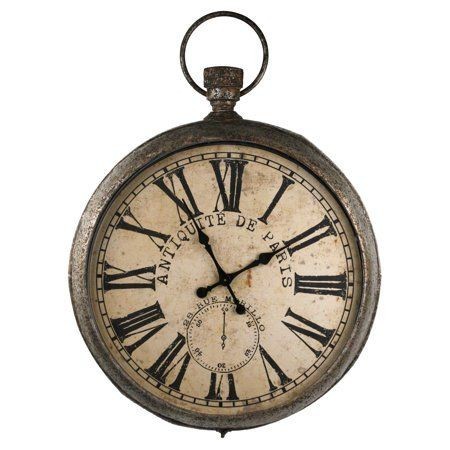
Example Invocation:
"By will and word, I call thee near,
Dwell within this vessel clear.
By pact and bond, remain with me,
Bound in trust, so mote it be!"
• Creating a Custom Spirit (Servitor or Thoughtform)-If you want to create a spirit rather than invite one, visualize the spirit’s form, name, and purpose. Charge the vessel with that energy and command it to awaken.
Example Statement:
"From thought to form, I give thee breath,
Bound to this vessel, life and depth.
In my service, thou shall stay,
By my will, by night and day!"
• Calling an Unknown Spirit-For ancestral work or unknown guides, use a pendulum or divination to confirm a willing presence. Never bind a spirit against its will.
Caution: Always establish rules and boundaries before allowing a spirit to reside in a vessel.
Sealing the Vessel-Once the spirit is inside, seal the connection to prevent interference.
• Wax Dripping: Seal with candle wax (black for protection, red for power, blue for wisdom).
• Thread Wrapping: Bind with string to secure the energy.
• Protective Sigil: Draw a sigil to prevent unwanted energy from entering.
Sealing Spell:
"Bound by word and light so bright,
This vessel holds, sealed tight.
By my will, this pact is spun,
This work is whole, it is done!"

Aftercare & Communication
Once the spirit has entered the vessel there is still much to be done to maintain the connection and keep the spirit comfortable in its new home.
Signs the Spirit Has Settled:
• Dreams or visions of the entity.
• Sudden cold or warmth from the vessel.
• Unexplained feelings of comfort or guidance.
• Divination confirming presence (tarot, pendulum, scrying).
How to Care for the Vessel:
• Offerings: Incense, candles, or small gifts to maintain the bond.
• Cleansing: Occasional gentle cleansing (avoid disrupting the spirit).
• Respect: Do not mistreat or neglect the vessel.
Releasing a Spirit (If Needed)
If you need to release the spirit, do so respectfully:
• Thank the spirit for its time.
• Offer a final gift (incense, a prayer).
• Open the vessel and say:
"With love and light, I set thee free,
Return now where thou choose to be."
• Bury, cleanse, or decommission the vessel afterward.
Spirit vessels are powerful tools when used correctly. They require responsibility, mutual respect, and ongoing care. Always trust your intuition when working with spirits, and never force an entity into a vessel against its will.

#spirits#spirit#Spirit house#Spirit vessel#spirit work#summoning#ghosts#ghost#demons#demonolatry#witchcraft#witch#magick#dark#witchblr#witch community#eclectic witch#eclectic#pagan#lefthandpath#spellcasting#spellwork#spell#occult#occulltism#esoteric#guide
189 notes
·
View notes